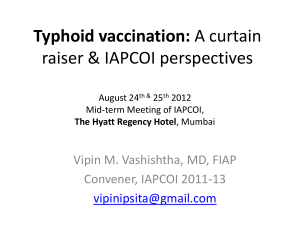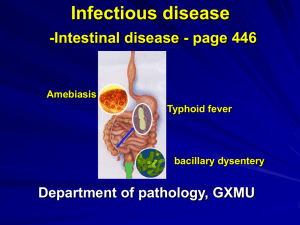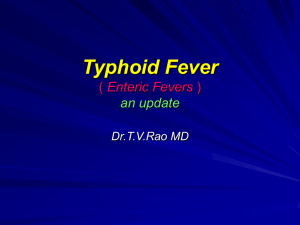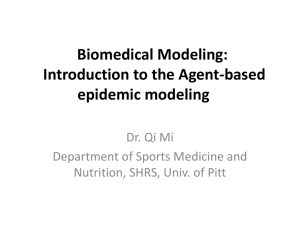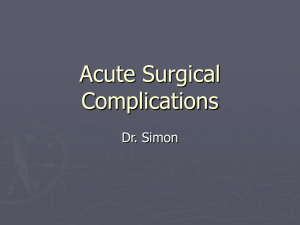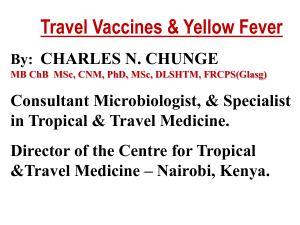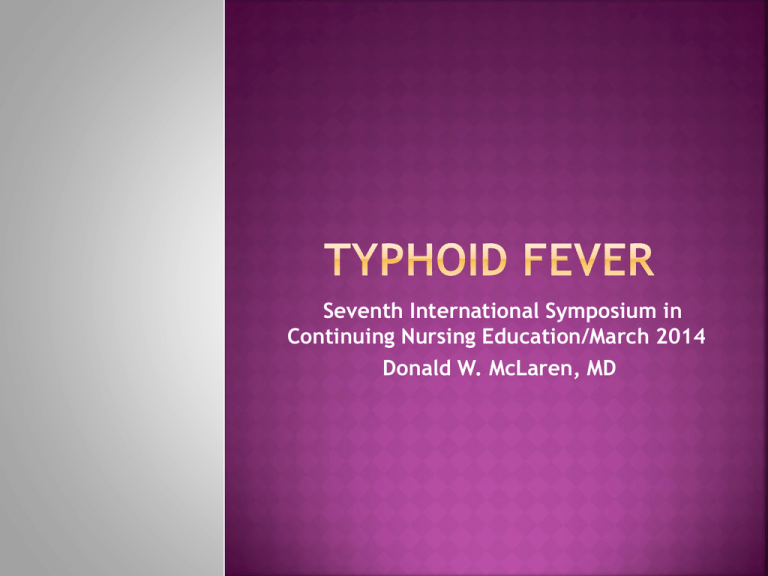
Seventh International Symposium in
Continuing Nursing Education/March 2014
Donald W. McLaren, MD
To
discuss epidemiology of typhoid
To discuss myriad of ways Typhoid can
present
To discuss challenges in diagnosis and give
some guidelines for diagnosis
To discuss antibiotic resistance patterns and
treatment recommendations for Typhoid
Typhoid
or Enteric fever is a systemic illness
with fever and abdominal symptoms
Caused by S. Typhi & paratyphi A, B, and C
Now known as Salmonella enterica serotypes
Typhi and Paratyphi A,B and C
Typhi meaning “typhus like” according to one
source. From Greek typhos - an ethereal
smoke or cloud that was believed to cause
illness and madness
Known
2000 years ago - may have been cause
of Great Plague of Athens at end of
Pelopennesian War 431-404 B.C.
1659 First description of epidemic typhoid
1837 first differentiated from typhus
1880 Carl Eberth discovered typhoid bacillus
1896 Widal test described by George Widal
1948 Antibiotic treatment became available
Increasing drug resistance since emergence
of Multidrug resistance (MDR) 1984-1989
© Homeschool Freebie of the Day. .
http://quigleyscabinet.blogspot.com/2010/07/typhoid-mary.html
Mary
Mallon (born 1869)
Emigrated from Ireland at about age 15
First healthy carrier identified in the U.S.
Unfortunately worked as a cook
Hired by Charles Warren, investment banker
6 of 11 in his household became infected
Hired civil engineer George Soper to
investigate
Suspected Ms. Mallon but getting stool and
blood specimen proved to be a real challenge
She with knife in hand put up resistance
After unsuccessful attempts, 5 police officers
took 5 hours to find her hiding in a closet
Known infected 47 – maybe many more – 3 died
Initially quarantined 3 years but released upon
promise never to cook again for others
Released once but started cooking again
Lived in enforced quarantine for 23 more years
Was demonized and butt of jokes
Became term for disease carrier
Salmonella
species – Typhi, Paratyphi A,B,C.
Typhi > Paratyphi: equal in severity now
Highly specific to humans - infection means
contact with infected individual, chronic
carrier or contaminated food or water
3 common antigens – O (body), H (flagella),
Vi (virulence antigen – lacking in about 10%)
Resistance to Amp, chloramphenicol (CMP),
TMP/SMX (Multidrug resistance or MDR) a
worldwide problem since 1989; increasing
resistance to fluoroquinolones (FLQ)
200-300
cases / year in U.S. 314 in 2006 –
about 0.42/100,000 travelers
80% have travelled (< 20% traced to
carrier) – 2/3 to India
Almost none had gotten the vaccine.
Most cases from India (47%), Pakistan,
Mexico, Bangladesh
India area travel (>100 case / million
travelers); SE Asia and Africa 5-14/million
Highest rate if visiting friends, relatives
© 2014 Top-10-List.com. All Rights Reserved.
http://top-10-list.org/2010/02/27/top-10-epidemics-list/2/
Infects > 21 mil/yr, kills >200,000 worldwide
Most prevalent in impoverished areas with
overcrowding and poor access to sanitation.
Mortality 9-13% pre antibiotics – now < 1%
Incidence
South-central and SE Asia, Southern Africa > 100 cases
/ 100,000 person years
Rest of Asia, Africa, Latin America, Oceana 10-100
cases/ 100,000 person years (but poor reporting)
Percentage of paratyphi rising
Resistance increasing from <1% 1986-89 to >12%
Children < 1 more susceptible, more severe
© Society for Science & the Public 2000 - 2013. All rights
reserved. https://www.sciencenews.org/article/cheap-shots%E2%80%94-typhoid-vaccine-shows-broad-coverage
Greater
dose - higher attack rate, shorter
incubation. About 30% of volunteers given
105 CFU, 10-20% with 103 CFU develop illness
Most cases get low dose with low attack rate
and long incubation of 2-3 weeks.
Ingested - pass stomach to SB. Doesn’t tend
to cause fulminant enteritis as do non–typhi
salmonella; 10-20% get D at some point.
Phagocytic cells take to sub-mucosal region
and proliferate – primarily at terminal ileum
Enter
Peyer’s patches which hypertrophy lymphs and mononuclear cells recruited.
Necrosis of sub-mucosal tissue leads to
abdominal pain, sometimes ileal perforation.
Dissemination from Peyer’s patches through
lymphatic system, blood to replicate in the
reticuloendothelial system
This is a major part of Typhoid which can
leads to prostration, sepsis, H-S megaly.
(Primary bacteremia often silent)
Remain in mononuclear cells in the liver, spleen,
LNs, bone marrow (Source of relapse, late
complications)
Proliferate then break into bloodstream
Need Fe for growth. Hemochromatosis carriers
and carriers of cystic fibrosis gene have
decreased susceptibility (and to cholera and Tb)
Low stomach acid (PPIs) - more susceptibile
Evidence mixed whether immune def (HIV) leads
to more severe or complicated typhoid as it does
for other salmonella organisms, but fare worse
“A
case of typhoid fever may present as a
disease clinically indistinguishable from
malaria, progress to a bacillary dysentery,
mimic a case of acute bronchitis, simulate a
fully fledged lobar pneumonia, cause an
acute abdomen with perforation, and then
finally in convalescence, with its evil spent,
linger on as an orchitis, a myocarditis or a
peripheral neuritis. The Seven Ages of Man
are scarcely greater, or more diverse in their
span, or the stage more prone to variety.”
“Typhoid
fever usually presents
nonspecifically with abdominal pain, fever,
chills and constitutional symptoms; as a
result many other diagnoses may be
entertained”
Hohmann EL. Epidemiology, microbiology, clinical manifestations, and diagnosis of typhoid
fever. UpToDate 2010. UpToDate.com
Personal
experience: one of hardest common
tropical diseases to dx early and accurately
Highly variable presentation
Often nonspecific symptoms
Many organs can be effected
Can mimic many other diseases
No good quick accurate test to diagnose
Test most often used to diagnose in third
world is totally unreliable
Starts 7-14 (5-21) days after ingestion
Week 1 - stepwise fever increase. Chills common.
Abdominal pain. Bacteremia. (Constipation in some Dry cough, HA, delirium and malaise)
Week 2 Fever plateaus: 103-4. Rose spots,
abdominal pain. Relative bradycardia and dicrotic
pulse. (abdominal distension and splenomegaly)
Week 3 – More toxic, anorexic. Tachycardia. Bowel
perforation, other complications, death possible.
Week 4 Slow improvement/resolution over weeksmonths, but can still get neuro, GI complications.
Weight loss and debilitation can last for months.
Can
vary a lot from classic presentation.
Tends to be insidious onset
Only 12% have classic stepwise fever
Can develop D instead of constipation
(especially in AIDS, children, but in 1/3 of
normal persons, specific to some outbreaks)
Non-localizing abdominal pain
Non specific flu like symptoms
Many atypical presentations
Strickland, GT (ed). Hunter’s Tropical Medicine and Emerging Infectious
Diseases, Eight Edition. Philadelphia: W. B. Saunders Company, 2000. p 477
Fever
most prominent feature and lasts 3-4
weeks untreated.
Tends not to be sudden and high (unlike
Dengue or Malaria)
Tends to be stepwise (think 2 steps forward,
and 1 step back each day)
Relative bradycardia common – slower than
would be expected for degree of fever but
not very helpful sign
17Strickland,
GT (ed). Hunter’s Tropical Medicine and Emerging Infectious
Diseases, Eight Edition. Philadelphia: W. B. Saunders Company, 2000. p 477
Magill AJ, et. Al. Hunter’s Tropical Medicine and Emerging Infectious Diseases. China: Saunders
Elsevier, 2013. pp 568-576
Rose
spots – small blanching 2-4 salmon-pink
colored macules or M-P rash mainly on chest,
abdomen and back. 30% at end of first
week. Lasts 2-5 days. Organism grows from
lesions which are clumps of bacteria, cells.
Coated tongue – varies from 50-95%. White,
yellow or brown sparing edge of tongue.
Stepwise rise in temperature
http://www.zipheal.com/typhoid/typhoid-fever-symptoms/3761
Figure 1
Bal, S. K. et al. CMAJ 2004;170:1095
Copyright ©2004 Canadian Medical Association or its licensors
http://www.henriettes-herb.com - Copyright 1995-2014 Henriette Kress.
Must
have high index of suspicion
Insidious onset – not sudden high fever
If present classic fever curve
Coated tongue
Rose spots
Often have abdominal findings.
If malaria ruled out or already treated, and
fever continues > 1 week must consider
typhoid.
Must
have high index suspicion
Consider if > 3 days non-focal fever.
Good hx, px, lab can R/O other conditions
Increased suspicion if: young age, T > 39oC,
ill appearance and any abdominal symptoms.
Consider W/U if >3 days non-localizing fever
+ any of these features
Likelihood this is typhoid increases with
length of fever: If > 7 days should be
evaluated and treated
(Magill AJ, et. Al. Hunter’s Tropical Medicine and Emerging Infectious Diseases. China: Saunders
Elsevier, 2013. pp 568-576
Can
present as pneumonia
Massive rectal bleeding
Delirium and coma
Uncommon: hepato-biliary, CNS, CVS,
Respiratory, GU, MS system complications.
Severe presentation ill or toxic appearing,
febrile > 1 week, moderate abdominal pain,
constipation or diarrhea.
Death most likely from GI perf, hemorrhage,
encephalopathy, seizures or pneumonia
Malaise,
anorexia and lassitude are
prominent in many cases.
HA is common
Dry cough is common as is vague abdominal
discomfort is common, constipation
Less common in antibiotic era
Much less splenomegaly (60 to 10%)
Fewer have rose spots (30 to 1.5%)
Much lower mortality (15 to < 1%)
Diarrhea now more common than constipation
especially in children and varies with location.
Not
real helpful but
Anemia (normocytic) common
WBC normal or decreased (15-30%) but
Tends to be increased in children, or if
perforation.
Increased ESR
Thrombocytopenia common
LFTs (ALT, AST, bili) about double in 90+%
LDH, CPK often elevated; Na, K can be low
Definitive
diagnosis a + culture
Positive from different places at different times
Bone marrow most consistently + throughout
disease – 90% sensitive up to 5 days after
antibiotics started
Stool + 30-50% early; 20% 2nd week; higher with
later increased shedding from GB. Urine less.
Blood 90% week 1, but less after first week
Blood overall 40-80%. Can increase with high
volume culture (10-15 cc) and multiple cultures
Rose spots – about 60% positive culture
Widal - measures agglutinating antibodies to H,
O antigens of S. Typhi.
Not specific, sensitive enough – no longer
considered acceptable for diagnosis.
Positive if prior infection or immunization.
Great lab to lab variability – most not reliable
O titer more specific, H more sensitive – > 1:160
(O titer) positive + in non-endemic area but
1:640 in endemic
Fourfold
increase in paired titers 2 weeks
apart helpful in half of cases.
Really not positive till 6-8 days (O) and
10-12 days (H) and negative in up to 30%
of culture proven cases. Peaks week 3-5
Newer
tests probably not available on field;
not that helpful acutely since antibodies not
present at beginning of illness, not very
available. Includes PCR
Gross intestinal hemorrhage
Relapse
Pneumonia
Intestinal perforation
Psychosis
UTI
Toxic myocarditis
Transient deafness
Toxic hepatitis
Meningitis
Endocarditis
Transient paralysis – LE
21%
12.5%
11.4%
1.9%
1.9%
1.9%
1.7%
1.4%
0.6%
0.3%
0.3%
0.3%
Hegazi AM. An update on: Typhoid Fever. http://www.
imbabafevers.com/.../An%20update%20on%20typhoid%20fever/Epidemiology%20of
%20typhoid%20fever.ppt
Magill AJ, et. Al. Hunter’s Tropical Medicine and Emerging Infectious Diseases. China: Saunders Elsevier, 2013.
pp 568-576
Pancreatitis or abscess
Empyema
Renal complications
Focal infections in many places
Post salmonella enteritis reactive arthritis 3.4%
Bed sores
CNS and neuritis (even psychosis)
Dehydration
Muscle degeneration and DVT
Hemolytic anemia
Acute cholecystitis
Rare in children but as high as 25% in adults
Classically in 3rd week (1-22 days) median 9 days
Up to 3% in developing countries (1% in U.S.)
Sx: worsening, sudden onset increased RLQ pain,
tachycardia, rebound fever, abdominal distention
tenderness or rigidity, leukocytosis in 3rd week
80% single perforation
May be masked by steroids
Tx: Surgery and broaden antibiotic coverage
High mortality
Delirium,
stupor and confusion
Sometimes altered consciousness or coma
Seizures most common in children with
increased mortality (usually < 35 cells in CSF)
Has been reported in up to 17% of patients.
High mortality around 50%. Decreased
mortality to 10% if treated with
dexamethasone in study out of Indonesia.
Pneumonia serious complication of severe
typhoid more common in children
Other
salmonella species
Malaria
Influenza
Shigella and other bacterial enteritis
Dengue
Typhus, Rickettsial infections
Pulmonary or abdominal Tb
Brucellosis
Many others: Trypanosomiasis, Leptospirosis,
Amebic liver abscess, Acute HIV infections,
Toxoplasmosis, Tularemia, leishmaniasis
10-15% (as high as 30%) mortality prior to CMP
Now < 1%; 0.2% in U.S.; higher in developing
countries – 2% in hospitalized patients
Higher in infants and elderly
Higher if antibiotics delayed
(3) Causes of death
Early shock, ARDS
Late perforation
Intestinal hemorrhage
Pneumonia
Other (myocarditis 4.4%)
27.4%
14.1
25.9
12.6
Hegazi AM. An update on: Typhoid Fever. http://www.
imbabafevers.com/.../An%20update%20on%20typhoid%20fever/Epidemiology%20of%20typhoid%20fever.ppt
Emergence of resistance to all first line drugs
(MDR) began late 1980s – Amp, TMX/SMX, CMP
(plasmid mediated)
Subsequently nalidixic acid resistance (NARST)
which is followed by FLQ (single point mutations)
NARST (NaR) considered marker for decreased
fluoroquinolone susceptibility.
FLQ resistance common from India
In 1996-1997 CDC reported 17% resistant to 5
drugs. (Now 13% MDR)
Sporadic ceftriaxone resistance but not clinically
much of a problem anywhere yet (MIC creep)
U.S. 1999-2006 43% resistant to at least 1 antibiotic
Resistance patterns change quickly –
Asia: increase NaR resistance from 5-50% (1993 – 2004)
2009 from Central India 98% NaR resistant
Full quinolone resistance India, Korea Nepal from 0-13%
In Africa only about 5% resistant to FLQs. 3.7%
Americas, 10.8% Middle East
(When not resistant to CMP – very good drug despite
1:20,000 aplastic anemia – quick response (3-5 days),
inexpensive, widely available, broad spectrum)
With decreased usage, some reemergence sensitivity
to older first line drugs – 2001-4 67% typhi and 80%
paratyphi sensitive to CMP
Resistance
has lead to favoring FLQs,
ceftriaxone, over 1st line drugs for initial
treatment
NARST especially problem in Asia – 70-90% in
some parts of India, Nepal and Vietnam.
Nalidixic acid resistant S. Typhi harbinger
of fully quinolone – resistant S. Typhi.
NaR resistant typhoid have slower and less
reliable response to quinolones.
Avoid FLQs as first line drugs in most of
Asia and especially India
Even
if “sensitive” to FLQ, tx of NARST with
FLQ less effective especially for short course
tx of 3-5 days. Defervesce slower (> 10 days
vs. 3.5 days) and > rate of treatment failure
Better options Azithromycin, 3rd generation
cephalosporins
Alternatives being investigated – include
imipenen, newer or higher doses of old
fluoroquinolones, combinations.
IF susceptible, Fluoroquinolones drug of choice
for fully susceptible organisms
High levels in GI tract after oral treatment
Bactericidal with good IC (intracellular) penetration
Oral and IV available; Not expensive
Acts rapidly - Defervesce 3-4 days
High cure rate; low failure rate with relapse rate < 2%
Concentrated in biliary tract – decreasing carrier rate
Cipro, ofloxacin, levofloxacin good – Not Norfloxacin –
poorly absorbed
Several studies show safety in children
If resistant, Azithromycin also gets good intracellular levels (IC levels 50-100X > blood levels)
Azithromax as effective as FLQ and have lower
failure rate and relapse rate than 3rd generation
cephalosporins
3rd
generation cephalosporins (i.e.
Ceftriaxone or cefixime) compared to FLQs
- longer to defervescence and higher
relapse rate
Ciprofloxacin
500 mg BID or Ofloxacin 400
mg BID po or IV X 7-10 days.
Ceftriaxone 2-3 gm IV, IM daily or Cefixime
20-30 mg/kg/day po divided BID X 7-14 days.
Alternatives if can’t take, resistant to FQs
Azithromycin 1 gm orally then 500 daily for 5-7
days OR 1 gm po daily X 5 days
CMP 2-3 gm/day divided q6hr for 14 days
Hohmann EL. Treatment and prevention of typhoid fever. UpToDate 2010.
UpToDate.com
A beta lactam
Ceftriaxone 100 mg/kg/day max 4 gm/day for 10-14
days (qD or BID)
Cefotaxime 150-200 mg/kg/day q6-8 hr max 12 g for
10-14 days
Cefixime 20 mg/kg/day q12 hours max 400 mg/day
10-14 days (po)
Fluoroquinolones
Ciprofloxacin or Ofloxacin 30 mg/kg/day BID max
1000 mg/day oral or IV for 7-10 days
Ofloxacin 30 mg/kg daily max 800 mg/day po or iv X
7-10 days
Hohmann EL. Treatment and prevention of typhoid fever. UpToDate 2010. UpToDate.com
Azithromycin
10-20 mg/kg to 1 g maximum
once daily for 5-7 days
If fully susceptible
Amox 100 mg/kg/d q8hr max 4 g/day for 14 days
TMP-SMX 8-12 mg/kg TMP 40-60 mg/kg SMX / day
divided every 6 hours max 320 mg TMP/1600 mg
SMX/day for 14 days.
CMP 75 mg/kg/d po q6hr max 3g/day: 14-21 days
Hohmann EL. Treatment and prevention of typhoid fever. UpToDate 2010.
UpToDate.com
Outside
U.S. Fluoroquinolones 1st line in
children and studies support they are ok if
fluoroquinolones-sensitive.
Treat at least 5 days after fever resolution
If susceptible usually defervesce 3-5 days
So much resistance from parts of S, SE Asia
fluoroquinolone should not be 1st choice– use
Azithromax or 3rd generation cephalosporin
CMP, Amp, TMP-SMX ok if not resistant
FLQ
– cartilage toxicity in immature animals
Large series show no evidence acute adverse
bone or joint events in humans.
For serious infection if no other options
they are ok for children
Optimal duration of cephalosporin treatment
not established – but need > 7 days
Ceftriaxone may be superior to cefotaxime
so give ceftriaxone or cefixime 10-14 days
http://thedhakaproject.blogspot.com/2011/02/treatment-of-typhoid-fever.html
Pay attention to nutrition, fluid and electrolytes
and monitor closely
In complicated typhoid (critically ill - shock,
obtundation, delirium, stupor, coma) studies
with CMP in past show 80% reduced mortality
from 55% to 10% with corticosteroids.
Dexamethasone 3 mg/kg then 1 mg/kg q6hr for
48 hours.
Perforation (most - 80% single – ileum) – primary
repair. Sometimes needs segmental resection
and appropriate antibiotics. 14-34% mortality.
Common
2-3 wks after fever resolution (1-10
weeks) after antibiotics stopped.
Relapse usually milder than initial infection.
In past 10-25% but more recently 1-6% newer antibiotics seem to be more effective
Usually can treat with same drug vs. longer
course with third generation cephalosporin.
But culture to be sure sensitive.
Can
shed normally up to 3 months in 10%
Can be in stool or less commonly urine
Chronic carrier = Excretion in stool (or
urine) > 12 months (Typhoid > Paratyphoid)
Incidence after Typhoid about 4 % (1-6%)
Increased with cholelithiasis
Urine carriage more common with kidney
stones, urinary schistosomiasis or BPH
Well but risk to others – esp. food preparers
In
past Ampicillin for 6-12 weeks +
cholecystectomy.
Now can treat try FLQ for 4 wks for near
90% cure rate.
If FLQ treatment fails, cholecystectomy (for
food handlers, day care workers, health care
workers)
Ciprofloxacin 500-750 mg BID for 4 weeks
Ofloxacin 400 mg BID for 4 weeks
Missouri:
after typhoid 3 stool cultures
needed for (child care, food handlers,
medical personnel) 24 hrs apart to see if
carrier - If so repeat every month till 3
consecutive negative cultures.
For chronic carrier (> 1 year) must have 6
consecutive negative cultures collected 1
month apart to go back to work.
Missouri Depart. Of Health and senior Services Communicable Disease Investigation and
Reference Manual. Typhoid fever. 7/03.
http://www.docstoc.com/docs/11383809/Spots-Typhoid-Fever © Docstoc® 2013. All rights
reserved.
CDC: “Boil it, cook it, peel it, or forget it”
2 vaccines – 50% effective at 3 years (85% initially)
Parenteral Vi polysaccharide vaccine (efficacy 55%) (> 2
yoa. Repeat 2 yrs);
Oral S. Typhi vaccine strain Ty21a (efficacy 51%) (> 6
yoa. Repeat 5 years)
About 1/6 of cases in travelers came after < 2 weeks
travel so recommended even for short travel.
Neither 100% effective – no good against paratyphoid
In U.S. 1994-99, ¾ of U.S. cases from travel; but only
4% vaccinated
Though only approved for > 6, studies show 57%
protection with oral vaccine in ages 2-5
Others on horizon
http://talesfromindonesia.wordpress.com/2012/06/22/oftyphoid-pills-and-crazy-prices-or-the-things-we-do-for-immunity/
Typhoid is a serious illness caused by S. Typhi
Typhoid can present many ways and mimic many
other diseases. Diagnosis requires a high index
of suspicion
The most common test for Typhoid, the Widal
test, is not reliable, is positive after one has a
vaccine, and should not be relied on
There is considerable drug resistance in typhoid.
FLQs are the DOC except in S, SE Asia. Due to
FLQ resistance, better choices there are
Azithromax or a 3rd generation cephalosporin
1Brusch
JL, Garvey T. Typhoid Fever. Emedicine
medscape.com 2010.
http://emedicine.medscape.com/article/231135-print.
Brusch JL. “Typhoid Fever.” Medscape Reference.
Accessed 1/22/2014 at
http://emedicine.medscape.com/article/231135-overview
Burkholder-Allen K, Rega P. “’Typhoid’” Mary Mallon.
Accessed 1/22/2014 at
http://www.docstoc.com/docs/161918129/%E2%80%9CTyp
hoid%E2%80%9D-Mary-Mallon---errata-llc
www.errata-llc.com/blog/files/Typhoid_Mary.ppt
Christenson JC. “Salmonella Infections.” Pediatrics in
Review accessed online in 11/2014. @
http://pedsinreview.aappublications.org/content/34/9/37
5
Division of Environmental Health and Communicable
Disease Prevention. Missouri Department of Health
and Senior services Communicable Disease
Investigation Reference Manual .
http://www.dhss.mo.gov/CDManual/Typhoidfever.pdf
Ekdahl K, de Song, B, Andersson Y. Travel Associated
Typhoid and Paratyphoid Fever. Medscape.com 2005.
http://www.medscape.com/viewarticle/511056_prin
t
Harrison’s Practice. Typhoid Fever.
http://www.harrisonspractice.com/practice/ub/view
/Harrisons%20Practice/141051/0/enteric_fever
Hegazi AM. An update on: Typhoid Fever.
http://www.imbabafevers.com/.../An%20update%20
on%20typhoid%20fever/Epidemiology%20of%20typhoi
d%20fever.ppt
7Hohmann
EL. Epidemiology, microbiology, clinical
manifestations, and diagnosis of typhoid fever. UpToDate 2010.
UpToDate reaccessed 1/22/2014 @
http://www.uptodate.com/contents/epidemiology-microbiologyclinical-manifestations-and-diagnosis-of-typhoidfever?source=search_result&search=typhoid&selectedTitle=1%7E7
7
Hohmann EL. Microbiology and epidemiology of Salmonellosis.
UpToDate 2010. UpToDate reaccessed 1/22/2014 @
www.worldortho.com/dev/index.php?option=com_content
&task=view&id=1778&Itemid=420
Hohmann EL. Pathogenesis of typhoid fever. UpToDate 2010.
UpToDate reaccessed 1/22/2014 at
http://www.uptodate.com/contents/pathogenesis-of-typhoidfever?source=search_result&search=typhoid&selectedTitle=3%7E7
7
Hohmann EL. Treatment and prevention of typhoid fever.
UpToDate 2010. UpToDate reaccessed 1/22/2014 @
http://www.uptodate.com/contents/treatment-and-preventionof-typhoidfever?source=search_result&search=typhoid&selectedTitle=2%7E7
7
Kadhiravan, T. Drug-resistant Typhoid Fever – Implications
for Clinical practice. Medicine Update 2007; pp. 584-586.
http://www.apiindia.org/medicine_update_2007/98.pdf
Kalra SP, Naithani N, Mehta SR, Swamy AJ. Current trends
in the Management of Typhoid Fever. MJAFI 2003; 59:130135.
Kumar R. Typhoid Fever. Power Point referencing World
Health Organization 2003. N Engl. J Med, Vol 347,No.22.
11/28/2002.
Magill AJ, et. Al. Hunter’s Tropical Medicine and Emerging
Infectious Diseases. China: Saunders Elsevier, 2013. pp 568576
Mirza, SH. Multi-drug resistant Typhoid – A Global Review.
Infections Disease Journal of Pakistan. Jan – March 2005:
pp; 17-20. http://www.idspak.org/journal/2005/JanMarch/page17-20.pdf
Missouri Depart. Of Health and senior Services
Communicable Disease Investigation and
Reference Manual. Typhoid fever. 7/03.
Zahran RF. Typhoid Fever.
http://www.slideworld.org/slideshow.aspx/Typh
oid-Fever-ppt-2844722
Rosenberg J. “Typhoid Mary: The sad story of a
woman responsible for several typhoid
outbreaks. About.com accessed on 1/22/2014 at
http://history1900s.about.com/od/1900s/a/typ
hoidmary.htm
Strickland, GT (ed). Hunter’s Tropical Medicine
and Emerging Infectious Diseases, Eight Edition.
Philadelphia: W. B. Saunders Company, 2000. p
477



